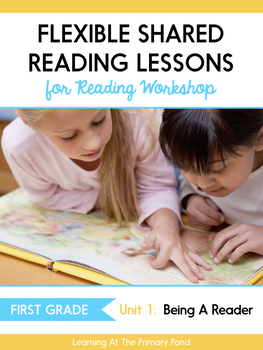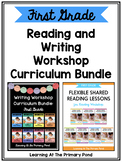Shared Reading Lessons for Reading Workshop: First Grade Unit 1
- Zip
What educators are saying
Also included in
- This is a bundle of shared reading lesson plans and reading strategy visuals for 1st grade students! The fiction and nonfiction units address a variety of decoding, comprehension, fluency, and vocabulary skills.This bundle is for you if you want to:- Engage your students in meaningful, fun whole groPrice $64.00Original Price $81.00Save $17.00
- This writing and reading bundle for first grade gives you lesson plans and printable materials to help you implement the "workshop" approach! The workshop model is extremely motivating for kids because it allows for student choice. Your students will not only grow as readers and writers (and illustrPrice $103.08Original Price $147.50Save $44.42
Description
This is a set of shared reading lesson plans and strategy visuals for first grade students. This unit is the first in a series of 7 and is perfect for use at the beginning of the school year or when you want to start reading workshop!
These lessons are very flexible - you can use the suggested texts or choose your own. The lessons can also be rearranged to meet your school's curriculum or scope and sequence!
Reading strategy lessons AND routines/procedures lessons are included in this unit. The reading strategy lessons will help you teach foundational literacy strategies to your first grade students. Decoding, fluency, and comprehension strategies are addressed. The routines lessons will help your students build reading stamina and learn to read or pretend-read independently! Independent and partner reading procedures lessons are included.
Also included are suggestions for high frequency words and vocabulary words to teach (these come from the recommended texts). Class checklists, an individual rubric, and a conferring form come with this unit, too.
FAQs:
What is shared reading?
Shared reading is an instructional practice in which you, the teacher, lead students in a reading activity where the students can clearly see the words of the text. You do some modeling during shared reading, but you also encourage students to participate in the reading as much as possible. Each shared reading lesson focuses on a strategy that students can then practice on their own, as they read (or pretend-read) independently.
What is the reading workshop model? If I don't use a reading workshop model, can I still use this unit?
The reading workshop model is an approach to teaching that typically includes a minilesson and independent student practice (reading / other literacy activities). As long as you want to teach some type of shared reading / minilesson to your first grade students, then this unit can work for you!
Where can I see a list of the lessons?
A list is included in the free preview! You can use this list to see the skills and strategies addressed in the lessons. There are 25 book-based strategy lessons and 27 routines lessons. Unit 1 is unique because I recommend teaching your "regular" shared reading lesson (with the book-based strategy lessons) but then also devoting time to building your students' reading stamina and teaching them how to read independently (with the routines lessons). You can teach a book-based lesson and a routines lesson each day, or alternate between these two types of lessons.
How long will each lesson take to teach?
The lessons are flexible, but I recommend setting aside 10-15 minutes for each book-based strategy lesson. The routines minilessons take a bit less time, usually 5-10 minutes.
When should I begin teaching these lessons?
Ideally, you should start these lessons just a few days into the school year. They start out very simple, so there's no need to wait very long to begin. (If you are not starting out at the very beginning of the year, you may be able to skip some of the lessons so that you progress through the unit more quickly.)
What books will I need to teach these lessons? What if I don't have access to those books?
Check out the preview for a complete list of suggested texts! For each week, I suggest two different options for books that you can use (you choose one). I also describe what type of text you might choose if you want to use a different text altogether. These lessons are VERY flexible in terms of the books you use! I recommend using one book per week, but you can also change books mid-week if you prefer.
Do I need big books to teach these lessons?
If you have big books, awesome! If not, no problem. You'll want students to be able to clearly see the words of the texts, however, so make sure that you have a document camera or some other means of projecting the texts for students to see.
What are the levels of the books?
The books for the first two weeks are above a first grade reading level - I chose engaging, repetitive texts that all students can enjoy. Students will not need to be able to read those texts on their own. Following week 2, the texts are at a level E and F (guided reading levels). You can easily adjust the text level, however, by choosing a different book for the lessons.
Can I skip lessons or use the lessons out of order?
Absolutely! These lessons are designed to be very flexible. I explain more about skipping lessons and using lessons out of order in the video instructions included in the unit. If you don't have time to do shared reading every day, it's not a problem (although I do recommend daily shared reading if you can manage it!).
How long will this unit take to teach?
I recommend spending 5 weeks on this unit. A suggested schedule is included, and the video directions provide some timing suggestions and strategies.
I teach a split-grade class and I'm not really sure which grade level I should purchase. Can you help?
Although everyone's situation is unique, my recommendation is to choose the LOWER grade level that you teach, and then "differentiate up" in small groups and conferences to challenge your stronger students. I recommend using only one unit, unless you have plenty of time to teach 2 minilessons each day. If you are in a situation where you teach more than 2 grade levels, however, you may want to consider teaching 2 minilessons per day or teaching the lessons in small groups.
Are the materials editable?
Editable versions of the lesson plans are included, yes! Other printables with clipart, however, are not editable due to the copyright agreements on the graphics I use.
What standards are addressed?
I've tagged the CCSS (Common Core) in this product - see the top of the page. You can use this list (with the CCSS) to correlate to any local standards you may use. Keep in mind that just because a standard is addressed does not mean that this unit teaches it to complete mastery (most standards are addressed again in later units).
This unit is part of the complete shared reading bundle for first grade, which you can find HERE!
Looking for a different grade level?
For Kindergarten, click HERE!
For second grade, click HERE!
What if I have more questions?
Feel free to leave a question in the Q&A section here on TpT, or email me at Alison@learningattheprimarypond.com. I'm happy to help!







